Mrs. Gould's AP Psychology's Helping Hands Website:
Mrs. Gould's AP Psychology class created a website that provides information and resources for some of the problems students at BHS might experience.
The website offers help and guidance to cope with these challenges, which include, for example, bullying, body image, relationships, drugs and alcohol, and other social/emotional issues.
The students in Mrs. Gould's class understand how hard it is to find information about possible difficulties or struggles that high schoolers can face. As a result they attempted to only use the most helpful and trusted resources in the Helping Hands website. Students from AP Psychology hope that students will find this website to be very useful.
Friday, May 31, 2013
Thursday, May 30, 2013
Day 132 - Jane Lynch, Pine Glen Elementary Grade 3
Twisters touch down in Room 205:
Guided reading lessons this week were all about tornadoes .In the wake of the recent tornadoes in the Mid-west we worked hard learning about how these storms can start and how to stay safe. We used the tornado bottle models to observe the formation of the funnel type column that forms during a tornado. This week we are writing our own weather reports and drawing weather patterns across the United States.
Guided reading lessons this week were all about tornadoes .In the wake of the recent tornadoes in the Mid-west we worked hard learning about how these storms can start and how to stay safe. We used the tornado bottle models to observe the formation of the funnel type column that forms during a tornado. This week we are writing our own weather reports and drawing weather patterns across the United States.
Wednesday, May 29, 2013
Day 131 - Ben Lally, Burlington High School English Department
Pre-Release Event for Ms. Sullivan’s Debut Novel – Golden Boy:
On June 18th, BHS’s own Ms. Sullivan will hold a book event to celebrate the release of her novel Golden Boy, which is scheduled for release by Penguin Publishing in late June. She has arranged for Penguin to send her some copies in advance of the release date just for BHS students & staff. On the 18th, Ms. Sullivan will hold a Q&A during each period that will be open to the English classes & electives, and she’s offering the opportunity to purchase a copy of the book in advance (and even get it signed!)
If you are interested in ordering a copy of the book, please download and fill out this form and bring it in to your English teacher or to Ms. Sullivan herself (Your English teacher may also have copies of this form available). BHS -GB PreOrder Form
Class of 2013 – if you are interested in ordering a copy, let Mr. Lally know and Ms. Sullivan can bring your copy to graduation (or, you can also come by to the event on the 18th)
Since Ms. Sullivan has to put in the order for these copies soon, please bring in the form and the payment by the end of this week (May 31).
For information about the novel, CLICK HERE
Thanks!

On June 18th, BHS’s own Ms. Sullivan will hold a book event to celebrate the release of her novel Golden Boy, which is scheduled for release by Penguin Publishing in late June. She has arranged for Penguin to send her some copies in advance of the release date just for BHS students & staff. On the 18th, Ms. Sullivan will hold a Q&A during each period that will be open to the English classes & electives, and she’s offering the opportunity to purchase a copy of the book in advance (and even get it signed!)
If you are interested in ordering a copy of the book, please download and fill out this form and bring it in to your English teacher or to Ms. Sullivan herself (Your English teacher may also have copies of this form available). BHS -GB PreOrder Form
Class of 2013 – if you are interested in ordering a copy, let Mr. Lally know and Ms. Sullivan can bring your copy to graduation (or, you can also come by to the event on the 18th)
Since Ms. Sullivan has to put in the order for these copies soon, please bring in the form and the payment by the end of this week (May 31).
For information about the novel, CLICK HERE
Thanks!
Tuesday, May 28, 2013
Day 130 - Eric Conti, Superintendent of Schools
The New MCAS is called PARCC:
Massachusetts may be joining a number of states who will be using the PARCC Test in conjunction with the adoption to the Common Core Curriculum Standards.
The presentations above and the one linked below were from the spring Superintendents’ Association gathering. The first contain national information and sample questions. The second is from the MA DESE. It is important to note that MA has not officially made a decision as to whether to adopt the PARCC Test although we are to prepare to implement the computer-based assessment during the 2014-15 school year.
Presentation_for_MASS_May_23_13_SJS_Nelhaus
Friday, May 24, 2013
Day 129 - Marshall Simonds Middle School 8th Grade Science Classes
Grade 8 Science – Parachute Testing Lab:
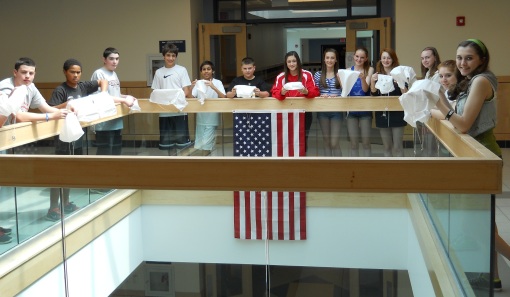
As part of their study of physical science, 8th grade students learn about the many forces (mostly invisible) that affect their lives. Most well known is the force of gravity, which accelerates a falling object at nearly 10 meters per second toward the earth’s surface causing the object to go faster and faster. Air resistance, the collision of air particles pushing upward against the falling object, reduces the acceleration of gravity until the object eventually reaches a maximum or terminal velocity.
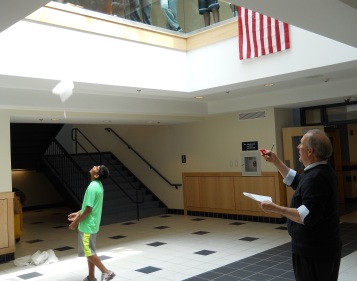
In one of their experiments, students tried to maximize air resistance by constructing a parachute out of a plastic bag and string, with 2 metal washers representing the payload. The most successful chutes were able to slow the descent to about 1 meter per second, just over 2 mph, a safe land speed for a parachutist!
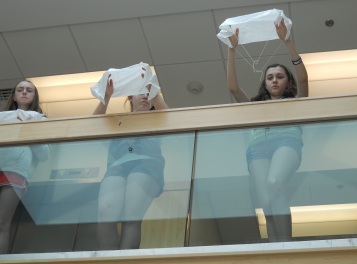

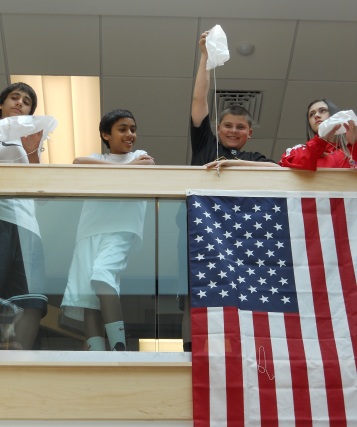



As part of their study of physical science, 8th grade students learn about the many forces (mostly invisible) that affect their lives. Most well known is the force of gravity, which accelerates a falling object at nearly 10 meters per second toward the earth’s surface causing the object to go faster and faster. Air resistance, the collision of air particles pushing upward against the falling object, reduces the acceleration of gravity until the object eventually reaches a maximum or terminal velocity.

In one of their experiments, students tried to maximize air resistance by constructing a parachute out of a plastic bag and string, with 2 metal washers representing the payload. The most successful chutes were able to slow the descent to about 1 meter per second, just over 2 mph, a safe land speed for a parachutist!



Thursday, May 23, 2013
Wednesday, May 22, 2013
Day 127 - Keith Mistler, Burlington High School Art Department
A Time for Reflection: 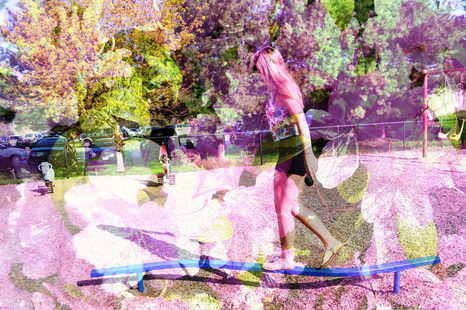 Student work: this image makes me long for the carefree life of High School!
Student work: this image makes me long for the carefree life of High School!
 Student work: this image makes me long for the carefree life of High School!
Student work: this image makes me long for the carefree life of High School!
As the school year begins to wind down, I am reminded that the school year never truly ends for teachers. The summer is a time to relax and recharge, but it is also a time for reflection. Reflection can sometimes by missed or skipped due to our busy schedules and fast-paced lives. Teachers can often skip reflection all together due to trying to cram everything in before the close of the school year. But taking time to reflect is a very important part of education. In my art classes, we work hard and fast on school projects in order to create, create, create! Talking about what was done really helps the high school students understand what they did and WHY. And it also helps me to understand what they thought about a particular lesson or project.
This summer, I plan on taking my time and renewing my love for teaching. Statistics state that most teachers leave the profession after only three years. I was just talking to my sister-in-law about the new rigorous educator evaluation system being put into place next year. Her question to me: "Do doctors or lawyers undergo an evaluation system like the kind that teachers are put through? How can teachers not get burnt out?" Great questions--and those answers are better saved for another post. My point is that this is my 3rd year of teaching, and I won't lie and say that I'm not exhausted! I have found that I have put so much time and effort into teaching (working what feels like around the clock), that I think I need a bit of a break. No, I'm not leaving; I just need time to reflect on the past three years and decide what works, what doesn't, and how should I continue in order to be successful in the future. During the last summer I have taken art courses, photographed weddings, and relaxed with friends and family; this summer I plan to do the same, but with more time spent reflecting and relaxing. How am I doing and what can I do better--both in my career and in life. I cannot imaging working as a CEO for 80 hours a week with 2 weeks or less of vacation. Our bodies and minds need to rest and recharge--that is why we need to sleep 7 hours a night. I feel that Americans neglect this rest and reflection even though there have been many studies that cite the benefits. Because teachers have the summers off, we are helping our students to succeed in giving ourselves that time to recoup and regenerate.
Next year I will have my first student teacher from Boston University. I am excited to welcome here here at Burlington High School, but I am also looking forward to helping her thrive and not be the third year fed-up teacher statistic in her future.
I have accomplished so much these past three years and I am proud of these accomplishments; I should be proud of them. I often teach my students to take a step back after creating and appreciate what they've done; share the work and be proud! I love my students and my school, and I want to be happy here with them. I would have never dreamed that I would love my job so much; but I truly am in my dream job. I want to feel that way in ten years, so this summer is for you, Mr. Mistler.
This summer, I plan on taking my time and renewing my love for teaching. Statistics state that most teachers leave the profession after only three years. I was just talking to my sister-in-law about the new rigorous educator evaluation system being put into place next year. Her question to me: "Do doctors or lawyers undergo an evaluation system like the kind that teachers are put through? How can teachers not get burnt out?" Great questions--and those answers are better saved for another post. My point is that this is my 3rd year of teaching, and I won't lie and say that I'm not exhausted! I have found that I have put so much time and effort into teaching (working what feels like around the clock), that I think I need a bit of a break. No, I'm not leaving; I just need time to reflect on the past three years and decide what works, what doesn't, and how should I continue in order to be successful in the future. During the last summer I have taken art courses, photographed weddings, and relaxed with friends and family; this summer I plan to do the same, but with more time spent reflecting and relaxing. How am I doing and what can I do better--both in my career and in life. I cannot imaging working as a CEO for 80 hours a week with 2 weeks or less of vacation. Our bodies and minds need to rest and recharge--that is why we need to sleep 7 hours a night. I feel that Americans neglect this rest and reflection even though there have been many studies that cite the benefits. Because teachers have the summers off, we are helping our students to succeed in giving ourselves that time to recoup and regenerate.
Next year I will have my first student teacher from Boston University. I am excited to welcome here here at Burlington High School, but I am also looking forward to helping her thrive and not be the third year fed-up teacher statistic in her future.
I have accomplished so much these past three years and I am proud of these accomplishments; I should be proud of them. I often teach my students to take a step back after creating and appreciate what they've done; share the work and be proud! I love my students and my school, and I want to be happy here with them. I would have never dreamed that I would love my job so much; but I truly am in my dream job. I want to feel that way in ten years, so this summer is for you, Mr. Mistler.
Tuesday, May 21, 2013
Day 126 - Sean Musselman, Burlington Science Center
How Much Does the Gray in an Elephant Weigh? Supporting Science Practice through Children's Literature:
One of my favorite storybooks as a child was, "Cloudy with a Chance of Meatballs." As a youngster, its imaginative storyline and humorous illustrative details kept me pouring over the pages and reaching for it again and again. Over the past several years I have spread my joy for this story as a gift at baby showers and birthday's for young readers. Besides taking pleasure in writing, "hope you grow up to be a great 'meat'eorologist!" on the inside cover, the author's soft-edged storyline highlighting the challenges humans face from extreme weather events are particularly relevant given climate projections for our next generation. Never mind the fact such hurdles for humanity come from precipitating food!
This week I found myself looking for a change-up at the local Barnes & Noble. With my former selection feeling a bit stale (nyuk-nyuk) I combed through the newer titles in search of a suitable replacement. I ultimately came across an enchanting rhyme book titled, "How Much Does the Gray in an Elephant Weigh?" by Erik Van Os, Elle Van Lieshout, Alice Hoogstad, and Mary Chris Bradley. The story follows a grandfather and his grandchild through a zoo. As they observe each animal, the grandfather openly wonders about the characteristics of each animal. Why does the giraffe have brown spots? Do the zebra's stripes go up or down? Do polar bears "beat the heat" with frozen treats? While many of the questions can be characterized as silly, the accompanying illustrations and clever rhymes will undoubtedly keep young readers interested and coming up with unusual predictions for answers!
Better still, the grandfather (and author by default) models one of the eight science practices being emphasized in the Next Generation Science Standards. Of course, "asking questions" has been at the foundation of scientific inquiry for a long time. But as science educators we are constantly looking for opportunities to model these practices and give students the chance to try them out for themselves. By reading picture books to kids that model these practices we are supporting student scientific literacy and a life-long love for reading simultaneously. Such picture books can also act as springboards to an investigation or exploration. This concept is by no means novel. The NSTA has been publishing recommendations for science and literature tie-ins for years, publishing monthly and annual recommendations.
There are plenty of titles available for kids that support science (the Ms. Frizzle series stands out in my mind as an obvious choice.) But I often find myself identifying books for the exposure to science content they provide. As our standards focus more on the practice of science I'll have to keep a keener eye out for books that include characters who are curious and exploratory, observe carefully (Encyclopedia Brown?), collect data and put their predictions to the test! If you have any already in your early reader repertoire please share in the comments below!
One of my favorite storybooks as a child was, "Cloudy with a Chance of Meatballs." As a youngster, its imaginative storyline and humorous illustrative details kept me pouring over the pages and reaching for it again and again. Over the past several years I have spread my joy for this story as a gift at baby showers and birthday's for young readers. Besides taking pleasure in writing, "hope you grow up to be a great 'meat'eorologist!" on the inside cover, the author's soft-edged storyline highlighting the challenges humans face from extreme weather events are particularly relevant given climate projections for our next generation. Never mind the fact such hurdles for humanity come from precipitating food!
This week I found myself looking for a change-up at the local Barnes & Noble. With my former selection feeling a bit stale (nyuk-nyuk) I combed through the newer titles in search of a suitable replacement. I ultimately came across an enchanting rhyme book titled, "How Much Does the Gray in an Elephant Weigh?" by Erik Van Os, Elle Van Lieshout, Alice Hoogstad, and Mary Chris Bradley. The story follows a grandfather and his grandchild through a zoo. As they observe each animal, the grandfather openly wonders about the characteristics of each animal. Why does the giraffe have brown spots? Do the zebra's stripes go up or down? Do polar bears "beat the heat" with frozen treats? While many of the questions can be characterized as silly, the accompanying illustrations and clever rhymes will undoubtedly keep young readers interested and coming up with unusual predictions for answers!
Better still, the grandfather (and author by default) models one of the eight science practices being emphasized in the Next Generation Science Standards. Of course, "asking questions" has been at the foundation of scientific inquiry for a long time. But as science educators we are constantly looking for opportunities to model these practices and give students the chance to try them out for themselves. By reading picture books to kids that model these practices we are supporting student scientific literacy and a life-long love for reading simultaneously. Such picture books can also act as springboards to an investigation or exploration. This concept is by no means novel. The NSTA has been publishing recommendations for science and literature tie-ins for years, publishing monthly and annual recommendations.
There are plenty of titles available for kids that support science (the Ms. Frizzle series stands out in my mind as an obvious choice.) But I often find myself identifying books for the exposure to science content they provide. As our standards focus more on the practice of science I'll have to keep a keener eye out for books that include characters who are curious and exploratory, observe carefully (Encyclopedia Brown?), collect data and put their predictions to the test! If you have any already in your early reader repertoire please share in the comments below!
Monday, May 20, 2013
Day 125 - Ms. Varrell, Pine Glen Elementary School Grade 2
Our Trip to the Ipswich River Wildlife Sanctuary:
Here's a quick pictorial look at our trip to the Ipswich River Wildlife Sanctuary in Topsfield, MA. Thank you so much to Ms. Cohen, Ms. Boogaard and Ms. Thyne (and Mr. Conte from Ms. Anderson's room) for their fabulous chaperoning throughout the trip!
 |
| Our naturalist, Bruce, explaining the tools we will use to catch 'land insects'. |
 |
| Nick, checking out a 'land net' for results. |
 |
| Later, we put our insects into small containers to look at more closely. |
 |
| There's a dragonfly in there somewhere! |
 |
| Bruce used a flow chart to show us how to determine what kinds of insects we found. |
 |
| Mr. and Mrs. Goose and their three goslings taking a swim on the Ipswich River. |
 |
| Learning about 'water insects'. |
 |
| Bruce, demonstrating the use of a strainer (sieve) to collect water insects. |
 |
| Insects like to hide! |
 |
| "Let's see what we got!" |
 |
| "I hope we find some tadpoles!" |
 |
| Cleaning the strainers before returning them to their place. |
 |
| Returning the insects to their natural habitat. |
 |
| What a fabulous class! |
 |
| Oh my! Whose class is this?? |
Subscribe to:
Posts (Atom)













.jpg)












